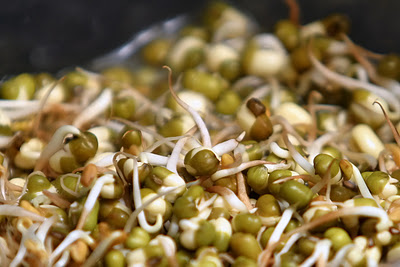

| Visitors Now: | |
| Total Visits: | |
| Total Stories: |

| Story Views | |
| Now: | |
| Last Hour: | |
| Last 24 Hours: | |
| Total: | |
What we’ve got here is failure to communicate: sprouts and food safety
Saturday, October 6, 2012 18:31
% of readers think this story is Fact. Add your two cents.
QUOTE from Powell and colleague’s great paper: “Yet, as demonstrated by some of the case studies, guidance does not equate with verification”
Doug Powell at Barfblog on a favourite subject:
Raw sprouts are the poster child for failures in what academics call, risk communication.
I’ve been thinking about this for a long time.
About 1999, graduate student Sylvanus Thompson started working with me on risk analysis associated with sprouts. He got his degree and went on to rock-star status in the food safety world with the implementation of the red-yellow-green restaurant inspection disclosure program with Toronto Public Health, but we never published anything.
I remember frantically flying to Kansas City to hang out with this girl in Manhattan (Kansas) I’d met a couple of weeks before, in the midst of the 2005 Ontario raw sprout outbreak that sickened over 700; Jen Tryon, now with Global News, interviewed me at the airport, with me wearing a K-State hockey shirt (that’s the joke; there is no hockey at K-State, and I was still employed by Guelph; and I was going to hang out with this girl).
I remember frantically flying to Kansas City to hang out with this girl in Manhattan (Kansas) I’d met a couple of weeks before, in the midst of the 2005 Ontario raw sprout outbreak that sickened over 700; Jen Tryon, now with Global News, interviewed me at the airport, with me wearing a K-State hockey shirt (that’s the joke; there is no hockey at K-State, and I was still employed by Guelph; and I was going to hang out with this girl).
After the German E. coli O104 outbreak that killed 53 people last year and sickened over 4,000, along with the ridiculous public statements and blatant disregard for public safety taken by sandwich artist Jimmy John’s in the U.S., I figured we really needed to publish something.
The basic conclusions:
The basic conclusions:
- raw sprouts are a well-documented source of foodborne illness;
- risk communication about raw sprouts has been inconsistent; and,
- continued outbreaks question effectiveness of risk management strategies and producer compliance.
We document at least 55 sprout-associated outbreaks occurring worldwide affecting a total of 15,233 people since 1988. A comprehensive table of sprout-related outbreaks can be found at http://bites.ksu.edu/sprouts-associated-outbreaks….
Get the full story at Barflog, and consider reading:
Erdozain, M.S., Allen, K.J., Morley, K.A. and Powell, D.A. 2012. Failures in sprouts-related risk communication. Food Control. 10.1016/j.foodcont.2012.08.022
http://www.sciencedirect.com/science/article/pii/S0956713512004707?v=s5
Erdozain, M.S., Allen, K.J., Morley, K.A. and Powell, D.A. 2012. Failures in sprouts-related risk communication. Food Control. 10.1016/j.foodcont.2012.08.022
http://www.sciencedirect.com/science/article/pii/S0956713512004707?v=s5
Abstract
Nutritional and perceived health benefits have contributed to the increasing popularity of raw sprouted seed products. In the past two decades, sprouted seeds have been a recurring food safety concern, with at least 55 documented foodborne outbreaks affecting more than 15,000 people. A compilation of selected publications was used to yield an analysis of the evolving safety and risk communication related to raw sprouts, including microbiological safety, efforts to improve production practices, and effectiveness of communication prior to, during, and after sprout-related outbreaks. Scientific investigation and media coverage of sprout-related outbreaks has led to improved production guidelines and public health enforcement actions, yet continued outbreaks call into question the effectiveness of risk management strategies and producer compliance. Raw sprouts remain a high-risk product and avoidance or thorough cooking are the only ways that consumers can reduce risk; even thorough cooking messages fail to acknowledge the risk of cross-contamination. Risk communication messages have been inconsistent over time with Canadian and U.S. governments finally aligning their messages in the past five years, telling consumers to avoid sprouts. Yet consumer and industry awareness of risk remains low. To minimize health risks linked to the consumption of sprout products, local and national public health agencies, restaurants, retailers and producers need validated, consistent and repeated risk messaging through a variety of sources.
Nutritional and perceived health benefits have contributed to the increasing popularity of raw sprouted seed products. In the past two decades, sprouted seeds have been a recurring food safety concern, with at least 55 documented foodborne outbreaks affecting more than 15,000 people. A compilation of selected publications was used to yield an analysis of the evolving safety and risk communication related to raw sprouts, including microbiological safety, efforts to improve production practices, and effectiveness of communication prior to, during, and after sprout-related outbreaks. Scientific investigation and media coverage of sprout-related outbreaks has led to improved production guidelines and public health enforcement actions, yet continued outbreaks call into question the effectiveness of risk management strategies and producer compliance. Raw sprouts remain a high-risk product and avoidance or thorough cooking are the only ways that consumers can reduce risk; even thorough cooking messages fail to acknowledge the risk of cross-contamination. Risk communication messages have been inconsistent over time with Canadian and U.S. governments finally aligning their messages in the past five years, telling consumers to avoid sprouts. Yet consumer and industry awareness of risk remains low. To minimize health risks linked to the consumption of sprout products, local and national public health agencies, restaurants, retailers and producers need validated, consistent and repeated risk messaging through a variety of sources.
@ What we’ve got here is failure to communicate: sprouts and food safety | barfblog:
2012-10-06 18:22:17
Source: http://gmopundit.blogspot.com/2012/10/what-weve-got-here-is-failure-to.html
Source:



